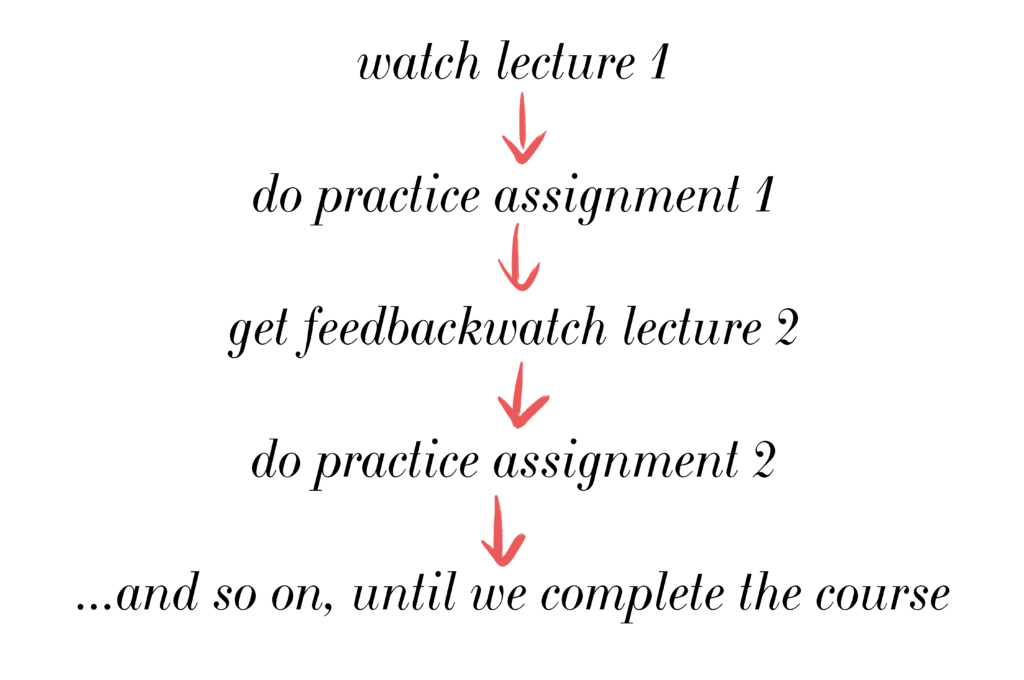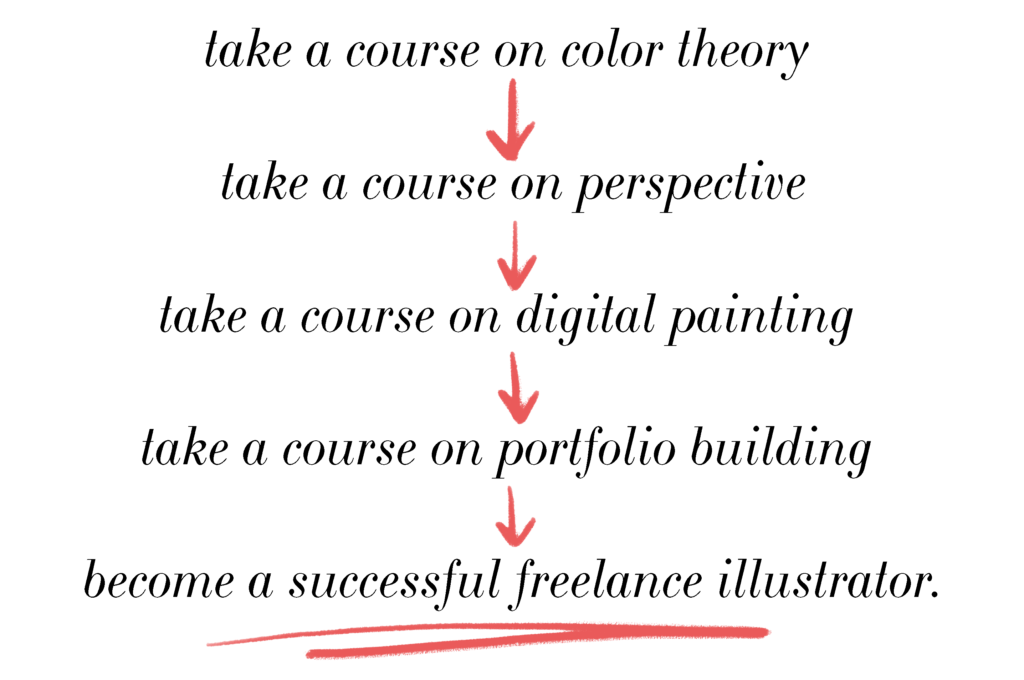Last week, a reader wrote in to ask:
“I’m stuck thinking my work might not be professional enough to get me clients. Should I take more courses focused on leveling up my technical skills before I start working on my freelance business?”
No.
You should start working on your freelance business at the same time as you’re honing your craft.
Here’s why.
Accumulating vs. Applying Knowledge
It’s never been easier to accumulate knowledge. There are thousands of tutorials on Youtube and thousands more you can buy. We can now download knowledge from the best in the industry, straight to our laptops.
These tutorials and classes follow a pattern we’ve been taught since our first days at school – pick a new skill to learn, watch the teacher demonstrate how it’s done, do our homework and get our grades.
When we learn new skills, we do everything in sequence:
 This is how we’ve been accumulating new skills and new knowledge throughout our school years and beyond.
This is how we’ve been accumulating new skills and new knowledge throughout our school years and beyond.
Now, applying knowledge is different.
When I take a motion design course, I’m operating on one level – the accumulation level – which has to do with the content of the lectures, funnelling theories and techniques off the page (or video) and into my brain.
The second level – application – has less to do with content and more to do with how well I can make connections between a broad range of skills. When I’m negotiating with clients, managing schedules and selling my work I’m setting the stage to land projects where I can apply the knowledge I’ve accumulated. Without this second level, I can’t make full use of my accumulated knowledge.
Applying knowledge is hard
We’ve talked about the two levels of knowledge: accumulation and application. We clearly need both – knowledge without application is the professor lost in the ivory tower; application without knowledge is the dumb orc.
But here’s where we’re prone to get stuck.
Accumulating knowledge feels familiar, and most classes have pings of short term satisfaction built in to keep us motivated. We watch an exciting lecture, do some exercises, submit our homework and get a jolt of approval and encouragement from the teacher’s feedback. Most non-certified online classes don’t have any rigorous requirements for graduation, so we can get high quality content that’s inexpensive and emotionally comfortable to acquire.
By contrast, applying knowledge takes a lot of time and we have to tolerate a lot of short term discomfort. Say our reader has taken an illustration course. Homework is straightforward – the exercises only require you to apply what you’ve just learned to a small, manageable problem. Sketch a box using 2D perspective. Paint a sphere using a yellow key and blue fill light. These exercises are a close 1:1 match between what we’ve just watched in a lecture, and what we’re expected to create.
Applying knowledge in the real world is much more difficult. Say our reader wants to be a freelance illustrator – she now has the first level of accumulated knowledge, but she is missing the second level that will allow her to apply that knowledge; skills such as:
- Drumming up new business
- Negotiating fees
- Managing projects
- Managing client expectations
This second level requires an interdependent set of skills – to drum up new business she’ll need to negotiate fees; to negotiate fees she’ll need to manage client expectations; to manage client expectations she’ll need to know how to manage projects and so on.
It’s not possible to teach the connections between skills.
Getting better at applying knowledge only comes from actually applying that knowledge. This is stressful, because outside of homework exercises there are no 1:1 matches between our accumulated knowledge and situations where we need to apply it – a fancy, tedious illustration technique cannot be applied to an eight hour rush project; the elaborate color scheme we planned must be changed on short notice because the client doesn’t like those colors.
Our reader’s new toolbag of illustration techniques will need to be applied and shaped by real clients and real projects in order for those tools to truly be hers.
Applying our new knowledge is a slow, often stressful and uncomfortable experience that is far from the curated, familiar and generally positive experiences we get from taking classes. We realize we need to adapt our accumulated knowledge to a dozen other factors before we can apply it – client demands, compressed timelines, various budgets – all the things that cannot be taught in classrooms.
Since applying our knowledge is often much more difficult than accumulating it, we can get stuck in a loop of accumulating more and more knowledge while neglecting that second level of application.
The temptation of sequencing
In light of how pleasant and familiar accumulating knowledge is, we can now circle back to our reader’s question:
“I’m stuck thinking my work might not be professional enough to get me clients. Should I take more courses focused on leveling up my technical skills before I start working on my freelance business?”
Taking an illustration course is comfortable and rewarding. Finding a client who will hire you for a project where you can apply that knowledge is hard.
So we play a little trick on ourselves.

We pretend we can’t apply knowledge until we’ve accumulated more. Our reader has sequenced her path like this:

We sequence things because we secretly hope accumulating more knowledge will eliminate risk. This is only partly true. Accumulated knowledge will tell us where the most obvious potholes are, but the most important lessons are taught by the potholes themselves.
The better path is one where both the accumulation and application happen simultaneously:
 Now the things she’s learning in the classroom are getting shaped by real world projects, and having that real world experience makes her better able to manage projects and communicate in a specific, relevant way that signals to future potential clients she knows what’s up.
Now the things she’s learning in the classroom are getting shaped by real world projects, and having that real world experience makes her better able to manage projects and communicate in a specific, relevant way that signals to future potential clients she knows what’s up.
Never hide behind technical education
At a certain point – you can feel it if you pay attention – you’ll be learning more things because you don’t want to face the discomfort of actually applying the lessons to real projects.
This is where the balance shifts, and you’ll know that further sequencing of education isn’t the right move – the right move is to dive in and apply what you already know.
Turn to more technical education only when you have a problem that you cannot solve otherwise. Use your lived experiences as a creative freelancer inform you what you need to learn next. Don’t take classes because everyone else is taking a class, and never take a class to avoid applying what you already know.
You might only be able to get smaller projects today. But small, real-world projects will tell you where your actual strengths and weaknesses are, instead of guessing at what you still need to learn to be “good enough”.
A few months of doing this and your path forward as a creative freelancer will be much clearer, you’ll be much more confident in your abilities and you’ll be standing on firm ground because you’ve done the hard work of tilling the soil and planting the seeds yourself.
***
Got a question? Leave a comment below or shoot me an email.
